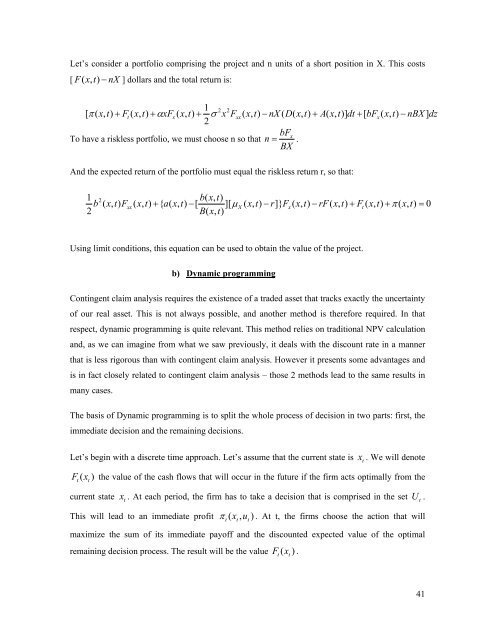Managing Risks of Supply-Chain Disruptions: Dual ... - CiteSeerX
Managing Risks of Supply-Chain Disruptions: Dual ... - CiteSeerX
Managing Risks of Supply-Chain Disruptions: Dual ... - CiteSeerX
You also want an ePaper? Increase the reach of your titles
YUMPU automatically turns print PDFs into web optimized ePapers that Google loves.
Let’s consider a portfolio comprising the project and n units <strong>of</strong> a short position in X. This costs[ F( x,t)− nX ] dollars and the total return is:1 2 2[ π ( x,t)+ Ft ( x,t)+ αxFx( x,t)+ σ x Fxx(x,t)− nX ( D(x,t)+ A(x,t)]dt + [ bFx( x,t)− nBX ] dz2bFxTo have a riskless portfolio, we must choose n so that n = .BXAnd the expected return <strong>of</strong> the portfolio must equal the riskless return r, so that:1 b(x,t)b 2 ( x,t)F ( , ) + { ( , ) − [ ][ ( x , t ) − r ]} F ( x , t ) − rF ( x , t ) + F ( x , t ) + ( x , t ) =xxx t a x tµXxtπ 02B(x,t)Using limit conditions, this equation can be used to obtain the value <strong>of</strong> the project.b) Dynamic programmingContingent claim analysis requires the existence <strong>of</strong> a traded asset that tracks exactly the uncertainty<strong>of</strong> our real asset. This is not always possible, and another method is therefore required. In thatrespect, dynamic programming is quite relevant. This method relies on traditional NPV calculationand, as we can imagine from what we saw previously, it deals with the discount rate in a mannerthat is less rigorous than with contingent claim analysis. However it presents some advantages andis in fact closely related to contingent claim analysis – those 2 methods lead to the same results inmany cases.The basis <strong>of</strong> Dynamic programming is to split the whole process <strong>of</strong> decision in two parts: first, theimmediate decision and the remaining decisions.Let’s begin with a discrete time approach. Let’s assume that the current state is xt. We will denoteF x ) the value <strong>of</strong> the cash flows that will occur in the future if the firm acts optimally from thet( tcurrent state x t. At each period, the firm has to take a decision that is comprised in the setThis will lead to an immediate pr<strong>of</strong>it π x , u ) . At t, the firms choose the action that willt(t tmaximize the sum <strong>of</strong> its immediate pay<strong>of</strong>f and the discounted expected value <strong>of</strong> the optimalremaining decision process. The result will be the value F x ) .t( tUt.41
















